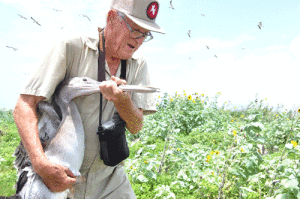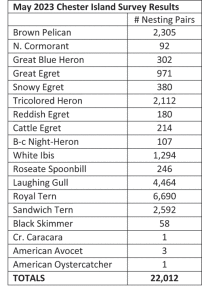
Chester Smith – First Warden of Sundown Island,
now renamed Chester Island, with Brown Pelican
As the construction of the Matagorda Ship Channel began back in 1962 to allow ocean-going vessels to travel from the Gulf of Mexico into Matagorda Bay, a small island started to be formed from all the sand and mud dredged up from the bay bottom. It didn’t take long for the new island 3 miles off of Port O’Connor, Texas to be discovered by waterbirds, and for ground nesters like gulls and terns to start nesting on the sand. As time went on, grass and small brush grew on the island and tree nesters began to nest there, too. The birds seemed thrilled about this new island – probably mostly due to it being a safe site, located far enough from other land that very few mammal predators could access it.
In 1975, the National Audubon Society could see that the birds liked the location of this island, then named Sundown Island, and so they leased the island from the Texas General Land Office. Jesse Grantham, Texas Director of Bird Conservation and Texas Sanctuaries Manager, was on assignment to find a warden to steward the birds, as well as monitor and maintain the island. Chester Smith was a Port O’Connor resident and came highly recommended by the local Port O’Connor Hardware store owner. Chester was known to be a trust worthy person who loved the outdoors, and with a “get it done” attitude and approach.
After the first interview in early 1986, a match was made and Chester became the first Audubon Warden of Sundown Island.
Chester was on a mission to bring back one of his favorite bird species, the Brown Pelican. Starting in the 1940s, the Brown Pelican population declined because of negative impacts of the pesticide DDT getting into their food chain. When the pelicans ate contaminated fish, it resulted in egg-shell thinning. Before the embryo had a chance to develop, the thin egg shell would break under the weight of the parents. As a result, the Brown Pelican was unable to reproduce effectively, and their numbers in Texas dropped to less than 100 birds in the late 1960’s, with fewer than 10 breeding pair.
Fortunately, the use of DDT was banned in 1972 – but the damage had been done, and Brown Pelican sightings had become rare in the Matagorda Bay area.
Chester teamed up with Ray Little, who was the Audubon Warden for the Corpus Christi area, where the Brown Pelican population had first begun slowly recovering, and attempted to reintroduce them to the Matagorda Bay area. Chester and Ray gathered up a few Brown Pelican chicks in the Corpus Christi area, and transported them to Sundown Island. Chester built a pen using wood and chicken wire, and put the chicks inside. He also put a bucket of seawater with small fish in it for them to eat. Every morning, Chester would go out to the island with his cast net, catch some fish, and restock the bucket. And it worked! The chicks survived and thrived, and Chester became a full-time cast-netting parent for a few weeks. Then, he started leaving the top to the enclosure open, and putting the bucket outside to coax the growing chicks outside the pen. Before long, they discovered the fresh minnows swimming just off of the beach, and no longer needed the bucket. And that’s how the Brown Pelican got its start on Sundown Island. Today, they are seen in great numbers all around Matagorda Bay and Port O’Connor.
Chester was recognized for his efforts to save the Brown Pelican with several awards and honors. Through good policy and the efforts of many other conservationists like Chester, the recovery of the Brown Pelican was very successful up and down the Texas Coast, and across the U.S. Due to this dramatic recovery, the Brown Pelican was removed in 2009 from the U.S. Endangered Species List.
And now, some 60 years after Sundown Island was first formed, waterbirds of 18 species arrive each Spring to take up residence on the island to build nests and raise their chicks. This low-lying, 70-acre bird island near Port O’Connor has become one of the top 3 largest rookeries along the Texas Coast for Colonial Waterbirds. In May 2023, the Texas Colonial Waterbird Survey recorded over 22,000 nesting pairs of colonial waterbirds of 18 different species nesting on Chester Island – including more than 2,300 nesting pair of brown pelicans.
This is where my DNA comes in… Chester was my father. My husband, Tim and I were Chester’s volunteer assistants for many years, and later became the wardens after Chester’s death in 2011. Chester was so proud of his involvement with Audubon that he was buried in his Audubon coveralls and hat with the red Audubon patch. And Sundown Island was renamed to Chester Island Bird Sanctuary in his honor.
The Aug-Sep 2023 issue of Texas Parks and Wildlife Magazine has a great article about Audubon marking 100 years of coastal conservation in Texas, and looking to challenges ahead. Photos in the article are from Chester Island, and feature several of our partners and volunteers!
Note: If you fish around the island, please DO NOT walk on the island, as there are eggs on the beach and many young fledglings hanging out on the shore line. We kindly ask you to stay out at least 50 yards from shore – whether in your boat or wading. And please no walking or fishing on the concrete mat, where many young birds hang out. The rookery island is protected by federal law, and we ask you to help us keep Chester’s Birds safe.

